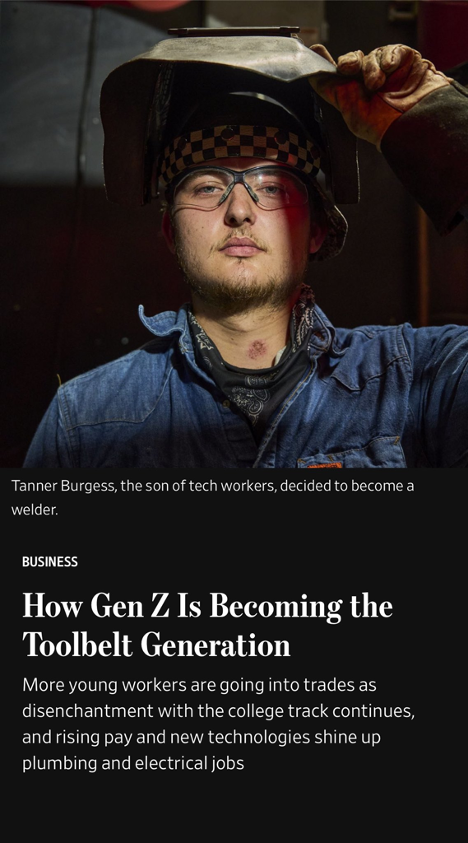
Hardware is Eating the World. Again.
Posted April 04, 2024
Chris Campbell
Hardware is eating the world.
More than 10 years after Marc Andreessen correctly wrote that “Software is Eating the World,” we’re in the first inning of a massive pendulum swing.
Sure…
Intel is investing $20 billion to build two new chip fabrication plants in Arizona. Samsung is building a $17 billion semiconductor factory. Tesla continues to scale up production at its factories in California, Nevada, New York and Texas. GM is investing $35 billion in EVs and autonomous vehicles through 2025, including new battery plants in Ohio and Tennessee.
But that’s not what I’m talking about. I’m talking about the moonshots.The paradigm shifters. The disruptors.
For example, while Boeing is investing in new facilities for aerospace R&D, manufacturing, and testing…Astro Mechanical wants to rebuild the airline industry and bring us into a new age of air travel.
While First Solar is expanding its solar panel manufacturing in Ohio, Heliogen is developing a concentrated solar system that could generate extreme heat for industrial processes and power generation.
While GM and Ford are investing billions into EVs and batteries, QuantumScape is working on a next-generation solid-state lithium-metal battery that could dramatically increase range, charging speed, and safety compared to today's lithium-ion batteries.
And while traditional construction remains largely unchanged, ICON is 3D printing entire buildings with advanced materials and robotics, with goals of creating affordable and sustainable housing on Earth and eventually on the Moon and Mars.
These companies aren't just iterating on existing technologies - they are swinging for the fences with entirely new approaches. They face major challenges in technology, scalability, and cost to realize their ambitious visions.
But if successful, innovations like super-efficient high-temperature solar, solid-state EV batteries, and 3D printed buildings could be transformative for their respective industries and for society as a whole. In the new wave of hardtech, we're seeing a resurgence of big, bold bets on the future.
And it gets better
Open-Source Hardware
It won’t happen overnight. But over the next decade, major sectors of the economy will see the first signs of transformation by accessible, collaborative hardware innovation.
What's driving this sea change? Why now?
For starters, the tools required to develop groundbreaking open hardware are now accessible to almost anyone.
Cheap single-board computers like Raspberry Pis and Arduinos allow basement tinkerers to create sophisticated devices. Digital fabrication technologies like 3D printers and CNC machines have gotten drastically cheaper. And a proliferation of makerspaces provides communal access to tools and know-how.
On the collaboration front, a thriving ecosystem has emerged around open-source hardware. Makers freely share designs, code, and knowledge on platforms like GitHub and Thingiverse. Open licensing fosters permissionless innovation. And crowdfunding -- especially crypto crowdfunding -- gives entrepreneurs an alternative to traditional venture capital.
The result is a Cambrian explosion of open hardware projects. Witness the remarkable variety of Arduino-based gizmos. Or the vibrant community designing prosthetic hands that cost a fraction of commercial alternatives. Or the many companies building on the open-source RISC-V chip architecture.
We're moving into an era where hardware is hackable, customizable, and infinitely remixable.
This is a watershed moment akin to the early days of the PC revolution or the birth of the web. Except this time, we’ll liberate both atoms and bits.
The impact will be profound.
Consider healthcare. Open-source designs are already powering better, cheaper diagnostic equipment for the developing world. As regulatory barriers fall, personalized and community-made medical devices could become the norm, not the exception.
Or take a look at the $80 billion robotics industry. Today, robots are mainly the province of deep-pocketed institutions. But a number of scrappy startups are developing open-source robot platforms that could lead to an explosion of new applications, from agriculture to elder care. It will be the PC all over again.
Consumer products will be transformed as well. The "manufacturability gap" between prototypes and mass production used to be a chasm, but it's rapidly narrowing. Whereas bringing a single product to market traditionally cost millions, open-source designs and digital manufacturing increasingly allow creative individuals to launch their own products - at scale and on a shoestring.
Even big industrial sectors will be affected. Leading auto companies are open-sourcing electric and self-driving vehicle designs. Aerospace giants are experimenting with open innovation. GE has an entire division dedicated to open-source hardware. These behemoths recognize that winner-take-all dynamics are giving way to a world where permissionless innovation drives progress.
To be sure, the open hardware revolution is still in early innings. Challenges around funding, distribution, and regulation remain. And the movement's egalitarian ethos can sometimes delay much-needed standardization and professionalization.
Hardware is, after all, hard.
But the trends are undeniable. We are entering a world where open-source hardware isn't just for hobbyists anymore. It will power serious machines and transform major industries.
Gen Z will be the heroes of this movement.

Companies that embrace this shift will flourish, while those that resist will wither. Schumpeterian creative destruction, indeed.
The opportunity is immense.
Policymakers and business leaders should be asking how we can accelerate the open hardware revolution to unlock innovation, entrepreneurship, and broad-based economic growth. Universities and vocational programs should be graduating more contributors, not just consumers. And investors should recognize that some of tomorrow's billion-dollar businesses will be built, not bought.
Institutions can't afford to just observe this trend from the sidelines. Like the upstarts powering it, they need to roll up their sleeves, get their hands dirty, and start hacking. The tools are cheap, the knowledge is accessible, and the community is global. There's never been a better time to build.
Over the next decade, the epic battle between hardware incumbents and open-source insurgents will play out across the economic landscape. The winners will be those who embrace distributed innovation - and aren't afraid to get a little open. The future of hardware is here. It's just not evenly distributed yet.
Of course, being too early is practically the same as being wrong.
